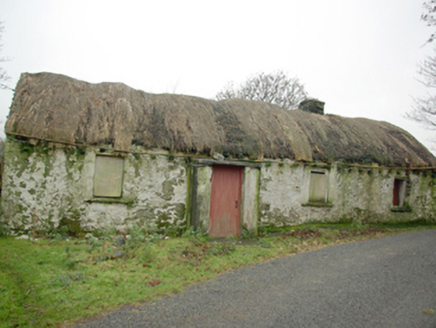Survey Data
Reg No
40841015
Rating
Regional
Categories of Special Interest
Architectural, Technical
Original Use
House
Date
1800 - 1840
Coordinates
154021, 384310
Date Recorded
14/11/2007
Date Updated
--/--/--
Description
Detached four-bay single storey thatched house, built c. 1820, having windbreak porch to the front elevation (south) and be outshot to the rear (north). Now out of use and derelict. Pitched roped reed thatch having stone pegs below eaves level. Rubble stone chimneystack offset to the east side of centre. Limewashed rubble stone walls. Square-headed window openings having cut stone sills and remains of timber sliding sash windows; windows now boarded. Square-headed door opening to windbreak porch having timber sheeted door. Road-fronted along small country laneway to the east of Gleann Cholm Cille/Glencolumbkille. Ruinous outbuilding adjacent to the east having remains of pitched roof (formerly thatched), rubble stone walls and square-headed openings.
Appraisal
Although now sadly derelict, this thatched vernacular house retains its early form and character, and is an appealing feature in the rural landscape to the east of Gleann Cholm Cille/Glencolumbkille. Modest in scale, it exhibits the simple and functional form of vernacular building in Ireland. Of particular interest in the survival of the thatched roof, which is now sadly becoming increasingly rare in Donegal. The rounded roof is a typical feature of thatched houses located close to the sea in exposed areas in the north-west of Ireland, while the pegs to the eaves were used to tie ropes (and sometimes nets) over the roof to secure it against the prevailing winds. The irregular-spacing of the openings to the front façade lends it an appealing vernacular character. The largely blank rear elevation is a typical feature of many small-scale vernacular dwellings in rural Ireland, while the bed outshot to the rear is a feature that is found on many vernacular buildings in Donegal and was used to house a bed adjacent to the hearth for warmth. This house represents a fine surviving example of a once ubiquitous building type in the rural Irish countryside, and is a valuable addition to the vernacular heritage of County Donegal. It is the only surviving thatched dwelling in a nucleated cluster of buildings or a clachan that has been in existence since c. 1837 at the latest (depicted on Ordnance Survey first edition six-inch map). Sensitively restored, this building would make a strongly positive contribution to the local area.







